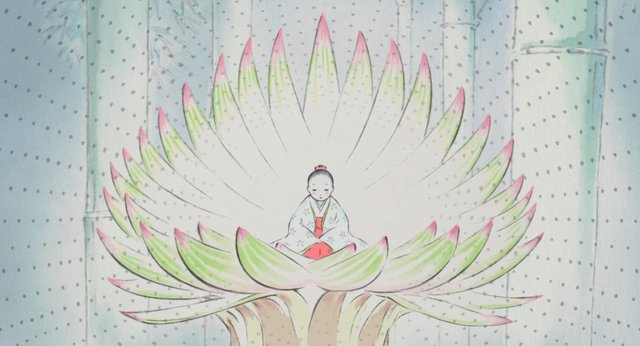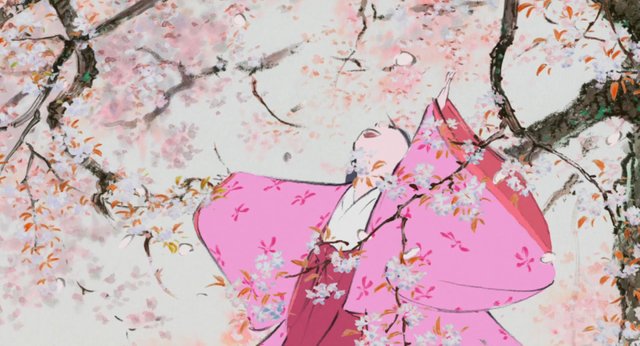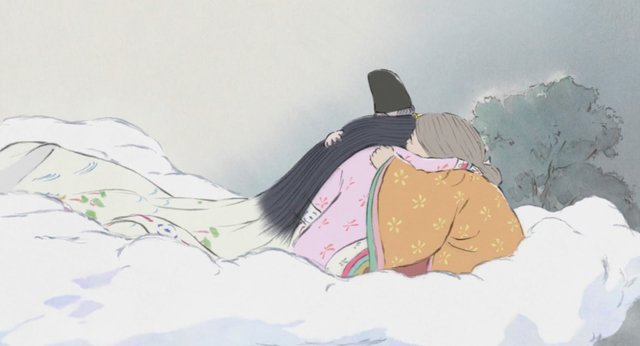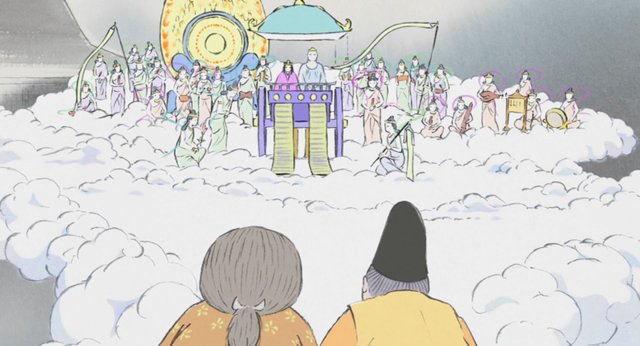El Cuento de la Princesa Kaguya (Análisis) / The Tale of the Princess Kaguya (Analysis) [ESP/ENG]
El día de hoy continuamos con los análisis de las películas de la casa de animaciones: el estudio Ghibli, hoy hablaremos de "El Cuento de la Princesa Kaguya", un film con un arte bastante peculiar y una historia de lo más interesante, así que comencemos.

"El cuento de la princesa Kaguya", última producción de Isao Takahata, quien junto a Miyazaki fundo el Studio Ghibli; está inspirada en una historia japonesa del siglo IX: "El cortador de bambú", de autor anónimo, es pensada como una obra maestra de la literatura japonesa, al ser tomada como la primera obra de ficción documentada de dicho país, dando lugar al nacimiento de erupciones en el Monte Fuji, que, según el folclore japonés, sucede cuando el enfado llega a la princesa Kaguya.
La protagonista es una joven llamada Kaguya, que significa luz brillante, el cual es un personaje lleno de bondad, con una sabiduría digna de divinidades y ante nada un personaje muy humano, que durante todo el film se logra ver que está muy influenciada por los deseos de quienes la rodean y no por los de ella misma, haciendo que su rápido crecimiento físico y mental sean influenciados por decisiones que ella no tomó.

A primera vista podría parecer una historia simplona, lo cual tendría lógica debido a lo prematura que es la historia original, la verdad es que cuenta con varios escenarios y personajes con una complejidad sorprendente. Por una parte, nos muestra un camino hacia el existencialismo, el cual que busca platicarnos acerca de la vida, sobre cómo hay que vivirla por nuestras propias decisiones, y no como los demás quisieran que la vivamos. Sobre todo, porque en la película los arquetipos aristócratas provenientes del Japón feudal se pueden notar con un punto de vista lleno de ironía, mostrándonos que, a final de cuentas, sus ideales no tienen valor y están atados a un mundo donde la apariencia y las reglas mandan; poniendo en contraste todo este mundo a la infancia de Kaguya en el campo, donde todo estaba más lleno de vida y se podía notar la humanidad de las personas.
Por otra parte, podemos ver el film desde la perspectiva del padre de Kaguya. Un hombre al que se le otorga una niña por decisión divina, siendo como una hija que de forma biológica nunca podría haber podido engendrar, una joven que pasa a ser su razón de existir, haciendo que todo lo que decida sea para el beneficio de la joven, aunque él mismo, sin el conocimiento necesario, cometa el error de dejarse influenciar por el sistema sin valor de la nobleza, guardando en su cabeza la idea la riqueza lleva a la felicidad y es lo más importante que existe en la vida o incluso en querer casar a su hija con un hombre, tanto por la importancia del mismo y sin tener en cuenta los pensamientos de la joven.

Hablando técnicamente, una de las características que más llaman la atención del film es su estética. Isao Takahata vuelve a utilizar el estilo que empleo para la película "Mis vecinos los Yamada", aunque de una forma más pura y perfeccionada; para poder alzar a la animación tradicional, desde el Studio Ghibli, en un tiempo donde no era el líder en animación. "El cuento de la princesa Kaguya" es un film cuya creación y producción duró alrededor de siete años dedicados a dibujar a mano fotogramas, muchos más de miles, y con un resultado hermoso y lleno de fantasía.
"El cuento de la princesa Kaguya" es la consagración de Isao Takahata como uno de los mejores directores de animación junto a su compañero Miyazaki. El golpe que recibió en la taquilla de Japón fue grande y, probablemente, no tiene la atención que se merezca a nivel internacional. Lo que se puede ver con claridad es que, con fracaso en el cine o no, solo el tiempo la podrá poner a este film animado como uno de las mejores de lo que va el siglo. Sin duda alguna una película que no se puede perder tanto un fan de Ghibli como un amante de las películas.
Rubén Conde

Fuente de las imágenes: Propia
Today we continue with the analysis of the films of the house of animations: the studio Ghibli, today we will talk about "The Tale of the Princess Kaguya", a film with a rather peculiar art and a most interesting story, so let's start.

"The tale of the princess Kaguya", last production of Isao Takahata, who together with Miyazaki founded the Studio Ghibli; is inspired by a Japanese story of the ninth century: "The bamboo cutter", by anonymous author, is thought of as a masterpiece of Japanese literature, to be taken as the first documented work of fiction in that country, leading to the birth of eruptions on Mount Fuji, which, according to Japanese folklore, happens when anger reaches Princess Kaguya.
The protagonist is a young girl called Kaguya, which means bright light, which is a character full of kindness, with a wisdom worthy of divinities and before anything a very human character, who throughout the film is able to see that is very influenced by the desires of those around her and not by her own, causing her rapid physical and mental growth to be influenced by decisions she did not make.

At first glance it might seem a simple story, which would be logical because of how premature the original story is, the truth is that it has several scenarios and characters with surprising complexity. On the one hand, it shows us a path towards existentialism, which seeks to tell us about life, about how to live it by our own decisions, and not like others would like us to live it. Above all, because in the film aristocratic archetypes from feudal Japan can be seen with a point of view full of irony, showing us that, in the end, their ideals have no value and are tied to a world where the appearance and rules rule; contrasting all this world to the childhood of Kaguya in the countryside, where everything was more full of life and you could notice the humanity of the people.
On the other hand, we can see the film from the perspective of Kaguya's father. A man who is given a girl by divine decision, being like a daughter that could never have been bred in a biological way, a young woman who becomes his reason for existing, making everything he decides to be for the benefit of the Young, although he himself, without the necessary knowledge, commits the error of being influenced by the worthless system of the nobility, keeping in his head the idea that wealth leads to happiness and is the most important thing that exists in life or even in wanting to marry his daughter to a man, both for the importance of it and without taking into account the thoughts of the young woman.

Technically speaking, one of the features that most attract the attention of the film is its aesthetics. Isao Takahata returns to use the style I use for the movie "My neighbors the Yamada", although in a more pure and perfected way; to be able to raise the traditional animation, from the Studio Ghibli, in a time where it was not the leader in animation. "The tale of the Princess Kaguya" is a film whose creation and production lasted around seven years dedicated to hand-draw frames, many more than thousands, and with a beautiful result and full of fantasy.
"The tale of the Princess Kaguya" is the consecration of Isao Takahata as one of the best animation directors with his partner Miyazaki. The blow he received at the box office in Japan was large and probably does not have the attention he deserves internationally. What can be seen clearly is that, with failure in the cinema or not, only time can put this animated film as one of the best of what the century. Without a doubt, a film that can not be missed by a Ghibli fan or a movie lover.
Rubén Conde

Source of the images: Own

se ve interesante la película la conseguiré para verla =)
Te la recomiendo muchisimo.
Genial animación, los japoneses tienen un arte increíble.
Ni que lo digas, uno de los mejores
Resteemed by @resteembot! Good Luck!
Curious? Read @resteembot's introduction post
Check out the great posts I already resteemed.
RESTEEMBOT IS FOR SALE
I COULD WRITE CODE FOR YOU